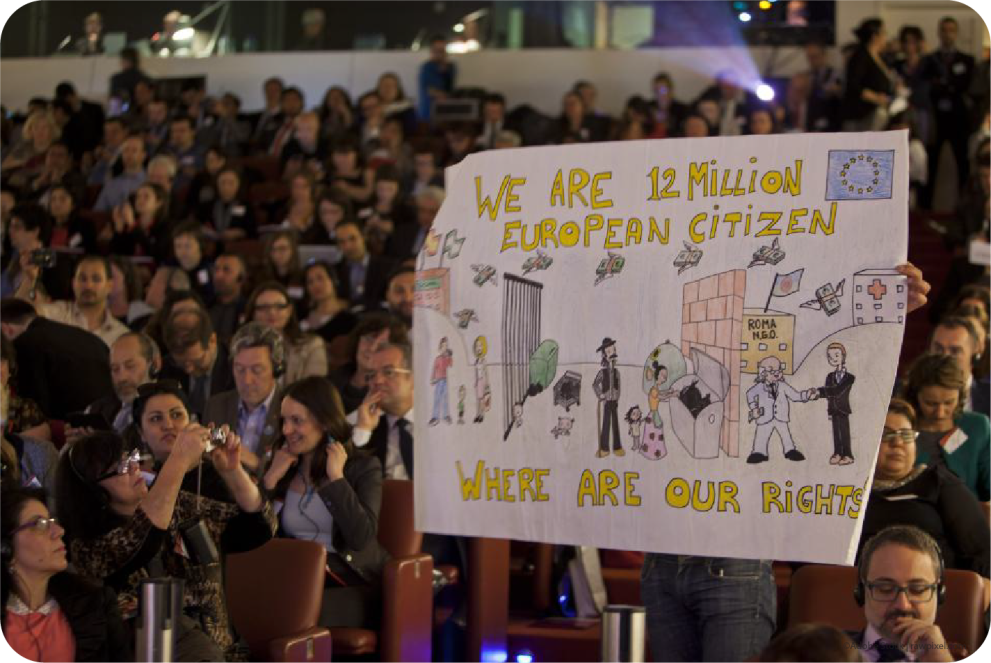It is the moment to show to the young generation that we can build a continent where you can be who you are, love who you want, and aim as high as you want.
A truly inclusive society empowers and uses everyone's potential. This is why the Commission has put equality at the heart of its agenda, striving to build a Union of Equality where all people can live free from discrimination.
In 2020 and 2021, the Commission adopted five strategies to create the conditions for everyone to live, thrive and lead regardless of differences based on gender, racial or ethnic origin, religion or belief, disability, age or sexual orientation.
- The LGBTIQ Equality Strategy 2020-2025
- The Gender Equality Strategy 2020-2025
- The Strategy for the Rights of Persons with Disabilities 2021-2030
- The EU Anti-racism Action Plan 2020-2025
- The EU Roma strategic framework for equality, inclusion, and participation 2020-2030

The right to be who you are
In the EU, discrimination based on any grounds (such as sex, racial or ethnic origin, religion or belief, disability, age or sexual orientation) is prohibited by law. But to many people, this is still a daily reality.
To make sure the fundamental rights of equality and non-discrimination are upheld, the Commission continuously proposes new policies and initiatives, focusing on promoting equality and inclusion.
The EU is striving to be a continent where everyone can choose whichever path they want in life, free from gender-based violence and stereotypes.
 70.2 points(out of 100) reached by the EU in the Gender Equality Index 2023
70.2 points(out of 100) reached by the EU in the Gender Equality Index 2023 33%of EU national parliament members are women
33%of EU national parliament members are women 10.7%is the overall gender employment gap
10.7%is the overall gender employment gap
On gender equality, EU countries have made significant progress, including by putting forward common legislation and integrating gender equality perspectives across different policy areas.
However, EU countries are still far from reaching full gender equality and progress is slow. Gender-based violence remains widespread. In the labour market, women are over-represented in lower paid sectors, and under-represented in decision-making positions. They still earn, on average, almost 13% less than men per hour. Research shows that women also generally carry out more housework than men. Gender stereotypes, affecting both women and men, are a root cause of such disparities.
To tackle gender inequalities that persist to this day, the Commission launched in 2020 the EU Gender Equality Strategy.

The European Union is at the forefront of better protecting lesbian, gay, bisexual, trans, intersex and queer (LGBTIQ) people’s rights.
 23 EU countrieshave equality legislation on sexual orientation going beyond employment
23 EU countrieshave equality legislation on sexual orientation going beyond employment 100+ initiativesfunded by the EU to support LGBTIQ people
100+ initiativesfunded by the EU to support LGBTIQ people
Sources: Rainbow map, LGBTIQ Equality Strategy 2020-2025 progress report
Despite our efforts to allow everyone to be who they are and love whom they want, LGBTIQ people are often discriminated against. A survey carried out by the European Union Agency for Fundamental Rights (FRA) in 2019 showed that discrimination on the grounds of sexual orientation is on the rise. The same survey found that two in five LGBTIQ people interviewed have experienced harassment for being LGBTIQ.
To tackle this, the Commission adopted the LGBTIQ equality strategy 2020–2025, which addresses the inequalities and challenges affecting LGBTIQ people and sets out targeted policies.

We are “united in diversity” in a continent that features many different cultures, traditions and languages.
But for the EU to live up to its motto and fulfil its meaning, we need to continuously fight racism and xenophobic movements, including combating antisemitism and anti-Muslim hate.
The EU Agency for Fundamental Rights (FRA) has carried out a range of surveys that show high levels of discrimination persist in the EU.

To tackle this, the Commission has adopted the Anti-racism Action Plan 2020-2025. Among other objectives, the plan
- introduces measures and funding programmes to fight racism and discrimination in access to the labour market, education and training, healthcare, social protection and housing;
- promotes a series of actions to address racial and ethnic stereotypes with the media, civil society and representatives of people with a minority racial or ethnic background;
- encourages Member States to adopt measures to avoid or compensate disadvantages linked to discrimination based on race or ethnic origin.
Anti-racism Action Plan 2020-2025
More inclusion for people with disabilities
Source: Strategy for the Rights of Persons with disabilities 2021-2030 (survey conducted among persons with disabilities)
Despite the progress made so far, persons with disabilities still face considerable barriers in our society. The Strategy for the Rights of Persons with Disabilities 2021-2030 aims to improve the lives of people with disabilities and ensure that they can enjoy their rights and participate fully in society and in the economy on an equal basis with others.
Under the strategy, a Disability Employment Package was adopted in 2022. As only half of 42.8 million persons with disabilities of working age in the EU are employed, such initiatives are providing guidance to employers and public authorities, while helping more people with disabilities access the labour market.
In recent years, several EU rules have also been adopted to make the EU more accessible for persons with disabilities, including:
- the European Accessibility Act, covering products and services
- and the Web Accessibility Directive
Other initiatives include
- the European Disability Card and the European Parking Card for persons with disabilities
- recommendations on accessible, supported housing for persons with disabilities
- the framework for social services of excellence for persons with disabilities (expected in 2024)
Strategy for the Rights of Persons with Disabilities 2021-2030

The Roma people are Europe’s largest ethnic minority. Out of 10-12 million, an estimated 6 million are citizens or residents of the EU.
Even though there is a discrimination ban in the EU, many Roma are still victims of prejudice and social exclusion.
In 2020, the Commission launched a 10-year plan to support the equality, inclusion and participation of the Roma community in the EU, where it laid out its targets for 2030, including:

- cutting the proportion of Roma with experience of discrimination by at least half
- reducing the poverty gap between Roma and general population by at least half
- cutting the proportion of Roma children who attend segregated primary schools by at least half in Member States with a significant Roma population
- cutting the gap in life expectancy by at least half
The equality task force
All five Union of Equality strategies combine targeted measures (such as equality legislation or dedicated awareness-raising activities) and efforts to mainstream equality in other policy areas.
To help mainstream equality across all policy areas, the Commission created a dedicated task force.




